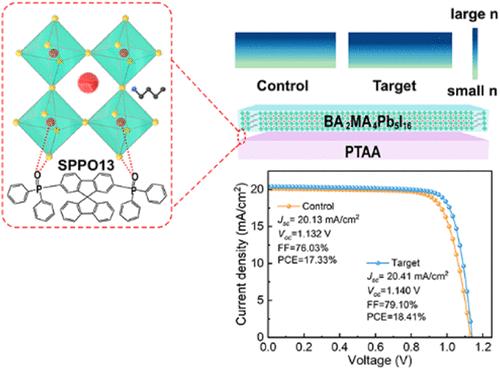抑制准二维钙钛矿底小n相用于高性能光伏应用
IF 8.2
2区 材料科学
Q1 MATERIALS SCIENCE, MULTIDISCIPLINARY
引用次数: 0
摘要
准二维(Q-2D)钙钛矿薄膜的底部小n相严重阻碍了其光伏性能的发展,因为它们在相应的太阳能电池中具有严重的低电导率和非理想的能带排列。在这项研究中,我们成功地抑制了Q-2D Ruddlesden-Popper (RP)钙钛矿(BA2MA4Pb5I16,⟨n⟩= 5)薄膜中的小n相的生长,方法是在钙钛矿前驱体溶液中引入2,7-双(二苯基磷酸基)-9,9 ' -螺芴(SPPO13)作为添加剂。有趣的是,我们的p-i-n器件中的空穴传输层聚[双(4-苯基)(2,4,6-三甲基苯基)胺](PTAA)由于π -π堆叠效应可以吸引SPPO13。结果,SPPO13集中在底部,SPPO13与PbI2的协同作用导致更多的[PbI6]4 -八面体聚集在Q-2D钙钛矿膜的下方。因此,更多的大n相留在底部,而不需要的小n相被抑制。优化后的器件实现了18.41%的功率转换效率,据我们所知,这是ba - ma基钙钛矿的最高值。此外,我们的设备还表现出出色的稳定性,在存储超过3500小时和最大功率点跟踪运行超过400小时后,分别保持99.5%和95.3%的初始效率。与传统方法主要解决体积或界面性质不同,该方法独特地结合了π -π堆叠效应和通过氧化膦基团的缺陷钝化,从而增强了结晶度、垂直取向和抑制非辐射复合。本研究为Q-2D钙钛矿太阳能电池的n相生长调控和光伏性能提升提供了新的途径。本文章由计算机程序翻译,如有差异,请以英文原文为准。

Suppressing the Bottom Small n Phases of Quasi-2D Perovskites for High-Performance Photovoltaic Applications
The bottom small n phases in quasi-two-dimensional (Q-2D) perovskite films significantly hinder their photovoltaic performance development due to their severely low conductivity and nonideal band alignment in the corresponding solar cells. In this study, we successfully suppressed the growth of small n phases in Q-2D Ruddlesden–Popper (RP) perovskite (BA2MA4Pb5I16, ⟨n⟩ = 5) films by introducing 2,7-bis(diphenylphosphoryl)-9,9′-spirobifluorene (SPPO13) as an additive into the perovskite precursor solution. It is interesting to find that the hole transport layer poly[bis(4-phenyl)(2,4,6-trimethylphenyl)amine] (PTAA) in our p-i-n device can attract the SPPO13 due to the π–π stacking effect. As a result, the SPPO13 concentrates at the bottom, and the coordination between SPPO13 and PbI2 leads to more [PbI6]4– octahedra gathering at the downside of the Q-2D perovskite film. Thereby, more large n phases remain at the bottom, and the unwanted small n phases are suppressed. The optimized device achieves a remarkable power conversion efficiency of 18.41%, which, according to our knowledge, is the highest value for the BA-MA-based perovskite. Moreover, our device also demonstrates outstanding stability, maintaining 99.5% and 95.3% of the initial efficiency after being stored for over 3500 h and under maximum power point tracking operation for over 400 h, respectively. Unlike conventional methods that primarily address bulk or interface properties, this approach uniquely combines π–π stacking effects and defect passivation through phosphine oxide groups, leading to enhanced crystallinity, vertical orientation, and suppressed nonradiative recombination. This work provides a new approach to regulate n-phase growth and promote the photovoltaic behavior of Q-2D perovskite solar cells.
求助全文
通过发布文献求助,成功后即可免费获取论文全文。
去求助
来源期刊

ACS Applied Materials & Interfaces
工程技术-材料科学:综合
CiteScore
16.00
自引率
6.30%
发文量
4978
审稿时长
1.8 months
期刊介绍:
ACS Applied Materials & Interfaces is a leading interdisciplinary journal that brings together chemists, engineers, physicists, and biologists to explore the development and utilization of newly-discovered materials and interfacial processes for specific applications. Our journal has experienced remarkable growth since its establishment in 2009, both in terms of the number of articles published and the impact of the research showcased. We are proud to foster a truly global community, with the majority of published articles originating from outside the United States, reflecting the rapid growth of applied research worldwide.
 求助内容:
求助内容: 应助结果提醒方式:
应助结果提醒方式:


